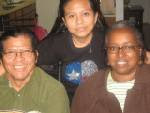The First Part Last
Bibliography
Johnson, Angela. 2003. THE FIRST PART LAST. New York, NY: Simon & Schuster. ISBN 0689849222.
Plot Summary
Why does this teenage boy have his infant daughter and where is the mother? These questions keep you searching from chapter to chapter as Bobby tells his story. Chapters about Bobby's relationship with his girlfriend Nia and the news of her pregnancy (then) alternate with Bobby's struggles to raise his daughter alone (now). He's sixteen, artistic, and he made a mistake. He has to grow up fast and be a "man" now that he understood what "Just Frank" meant when he asked him "was he being a "man." His parents support his decision to raise Feather but it's his older brother that shows him the sacrifices you make for love. It's a story of love so deep that you are welling to start a new beginning. "I can tell you how it is to feel as brand new as my daughter even though I don't know what comes next in this place called Heaven."
Critical Analysis
Ms. Johnson tells a story about two teenagers. It's a twist on the traditional theme of the teenage pregnant girl. A young teenage boy tells his story. The book cover draws the young blacks by it's a black male holding an infant. Ms. Johnson used Bobby to scold himself about the mistake he made. "Yeah, Mrs. Wilkins, I know that this is a tragedy "cause you all expected more responsible behavior from us."
Description of skin tone reveal cultural markers. Feather and Coco are "the same carmel color." Johnson describes his friend K,Boy, "K-Boy takes his baseball cap off and his locks fall all over his face. He's mahogany and tall."
Traditional Spanish title, Coco Fernandez, and reference to a Jewish holiday, "Haven't been this many people in the place since my Bat Mitzvah," suport the setting in New York.
The setting is also brought out by the name of locations,Chelsea, Upper West Side and the subways. Paul moves away from the "city" to be near his kids who live in a small country town.
Severl passages of teenage slang are used to develop the authenticity of the age level. You can imagine the New York accents as they say things like, “Everything is different if there ain’t no love.”, “J.L. yawns, ‘What up?’, “He says, ‘Too right you should keep her, man, too right.”). The language works to capture the “rhythm of the streets”.Bobby used passionate language to describe how he loved his daughter. The ending chapters felt rushed and didn't connect me to the closing chapter. The twist on the theme from teenage girl to a teenage boy presented a good novel.
Book Review
Michael Printz Award
School Library Journal
Bobby's parents are well-developed characters, Nia's upper-class family somewhat less so. Flashbacks lead to the revelation in the final chapters that Nia is in an irreversible coma caused by eclampsia. This twist, which explains why Bobby is raising Feather on his own against the advice of both families, seems melodramatic. So does a chapter in which Bobby snaps from the pressure and spends an entire day spray painting a picture on a brick wall, only to be arrested for vandalism. However, any flaws in the plot are overshadowed by the beautiful writing. Scenes in which Bobby expresses his love for his daughter are breathtaking.
Connections
Young teenage boys will be attracted to the book cover, a young black father holding his baby.
The book is also on audio which could inspire a dramatic presentation for young actors.
Book connections
Bechard, Margaret, HANGING ON TO MAX. ISBN 0689862687
Giles, Gail, SHATTERING GLASS. ISBN 0689858000
Thursday, September 25, 2008
Subscribe to:
Post Comments (Atom)


No comments:
Post a Comment